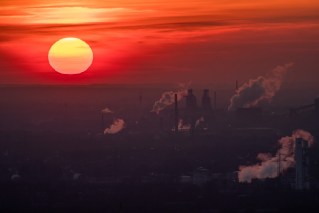Massive ice sheets in Antarctica are melting faster than first thought and the opportunity to reverse the process has now been lost, according to the latest climate change research.
The melting glaciers, located in the West Antarctic, could cause the ocean levels to rise more than the 1 to 1.5 metres predicted for the coming century.
The revelations triggered concern from organisations like NASA, which said that landmarks like the Statue of Liberty would be jeopardised. A rise in ocean levels of that magnitude could inundate coastal Australian cities.
Most alarmingly, the scientists said it was not a matter of ‘if’ but ‘when’ the affects started being noticed.
Dr Eric Rignot of the University of California, the US glaciologist responsible for one set of the new findings, told The New Daily that the melting of glaciers in the Amundsen Sea sector of West Antarctica “had reached the point of no return”.
“[A]ll ice in this sector will melt to sea in the coming decades to centuries,” he said.
“If climate warming is controlled or even reversed to what it was like in the 1970s, we should slow down the retreat considerably, but it would not stop it or even reverse it,” Dr Rignot said.
Dr Rignot and his team used satellite images collected between 1992 and 2011, as well as photos taken from the air, to measure changes in six huge ice sheets.
A second group of scientists have confirmed Dr Rignot’s findings using different methods, showing that Antarctica is losing 160 billion tonnes of ice per year, mainly in the West.
‘Irreversible retreat’
Professor Barry Brooke, a leading environmental scientist at the University of Adelaide, agreed that the accelerated melting is effectively unstoppable, at least in this century.
“Even if we could implement all of our policies today to stop human-caused climate change and even start to induce cooling, it’s going to make many decades for that to start to cool the oceans and to reverse that loss of ice,” he said.
“If it’s happening faster than the previous expected rate, then that essentially throws out all of the previous predictions,” he added.

Map showing the regions (in red) the Antarctic ice is retreating. Map: European Space Agency
Why is this happening?
There are very large glaciers (basically frozen rivers) in Antarctica that discharge ice into the ocean. Usually, the rate of ice lost to the ocean is roughly equal to the amount of snow falling inland.
But this balance is being thrown out by global warming, with potentially disastrous consequences, according to Professor Brooke.
“You’re always getting ice coming out, but you’re also getting ice dumped on top. But what has been observed recently in some of these large glaciers in West Antarctica is that the rate of discharge is exceeding the rate of recharges from the snowfall.”
The Antarctic ice already floating in the ocean is of little concern (although water does expand as it warms). It’s the ice melting off the continent that is the real cause for alarm.
Dr Nerilie Abram, a climate change scientist at the Australian National University, has conducted research on the frozen continent.
She says the reason for Antarctica’s rapid ice melt is that greenhouse gases are being released into the atmosphere, strengthening the westerly winds, which then warm the ocean in this part of the world. The warmer water then eats away at the glaciers from below.
Could it get even worse?
Dr Bradley Opdyke, a senior lecturer and researcher in climate change at the Australian National University, is currently working on a joint American-Australian project that could uncover even more bad news.
Dr Opdyke and his colleagues will soon collect ice cores from the Totten glacier in East Antarctica, near Australia’s Law Dome research station.
East Antarctica is thought to be much less likely to melt, but this particular glacier is starting to look “pretty vulnerable,” he said.
“Right now it really looks pretty vulnerable, much like the West Antarctic,” he warned. “It would be one of the few places in the East Antarctic that would be vulnerable to this kind of thing.”
If the eastern part of the continent also starts losing ice to the ocean, then the sea will rise even higher above previous estimates.
What parts of Australia are at risk?
When asked how these unexpected sea level rises would impact Australia specifically, Dr Rignot said it is as yet unknown, but that “significant variations will exist at the regional level depending on the location of the source of the melt water.”
“We have not actually calculated the pattern corresponding to the Amundsen Sea but it could be done,” he said.








